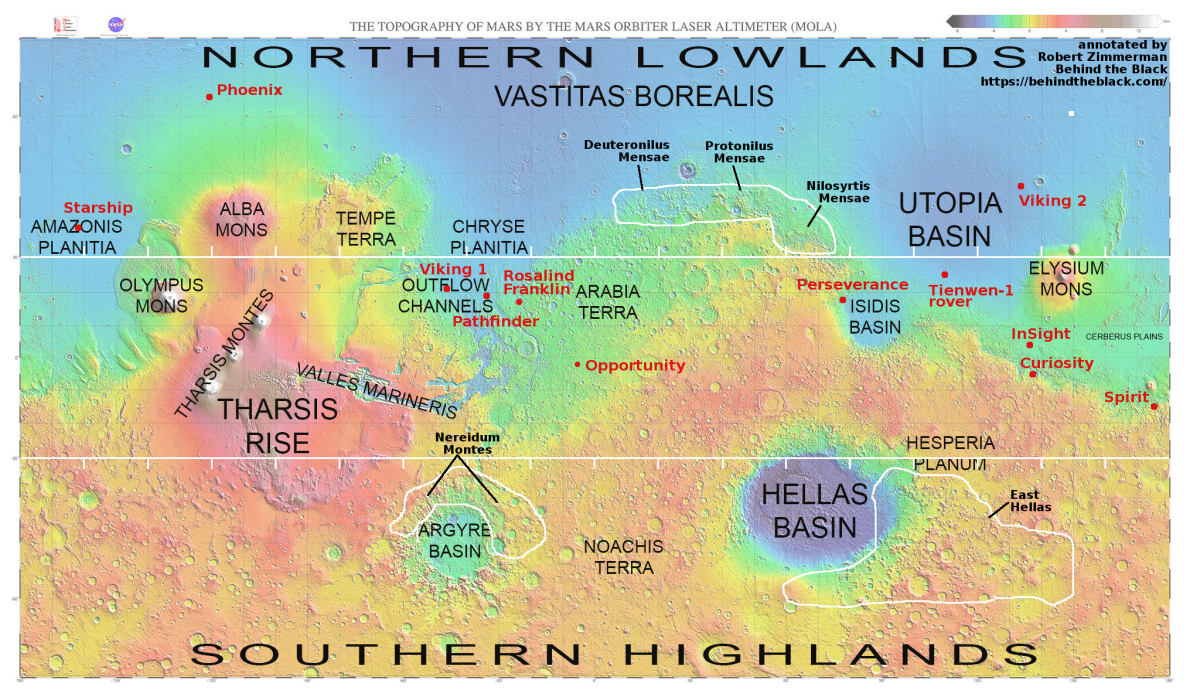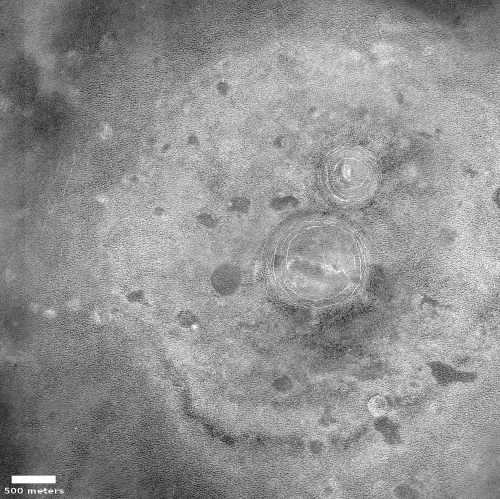Ice volcano in the Martian high northern latitudes?
That the Martian surface becomes increasingly icy as one approaches its poles is becoming increasingly evident from orbital images. Today’s cool image provides us another data point.
The picture to the right, rotated, cropped, reduced, and enhanced to post here, was taken on January 4, 2023 by the high resolution camera on Mars Reconnaissance Orbiter (MRO). It is once again another terrain sample image, taken not as part of any particular research project but to fill a gap in the camera’s schedule so as to maintain its temperature. With such pictures, it is hard to predict what will be seen, though the scientists try to find interesting things. In this case the camera team succeeded quite nicely, capturing what appears to me to be a small volcano with two calderas.
This volcano however has almost certainly not spouted lava but mud and water.
The picture is located at 60 degrees north latitude, well north of the 30 degree latitude line that marks the limit of near ice features on the Martian surface. The white dot on the map below marks this volcano’s location, north of Utopia Basin, the largest impact basin on Mars where many glacial and ice features are found. The white outlined regions are dense with many glaciers. The 30 degree hatched lines delineate the dry equatorial regions.

What makes these ice features different here is that the ice appears hard and solid. Rather than splatter or flow, features common farther south within the basin, the ice here cracks.
We do not know the makeup of the material that formed the apron around these icy calderas. While almost certainly impregnated with water ice, dry ice and mud could also be components. For example, this picture was taken in the spring. The thin mantle of dry ice that covers most everything from 60 degrees latitude and above at both Martian poles during the winter is at this moment beginning to sublimate away. Some of the features here likely include that disappearing mantle. Its seasonal appearance might in itself contribute to shaping this ice volcano.
On Christmas Eve 1968 three Americans became the first humans to visit another world. What they did to celebrate was unexpected and profound, and will be remembered throughout all human history. Genesis: the Story of Apollo 8, Robert Zimmerman's classic history of humanity's first journey to another world, tells that story, and it is now available as both an ebook and an audiobook, both with a foreword by Valerie Anders and a new introduction by Robert Zimmerman.
The print edition can be purchased at Amazon or from any other book seller. If you want an autographed copy the price is $60 for the hardback and $45 for the paperback, plus $8 shipping for each. Go here for purchasing details. The ebook is available everywhere for $5.99 (before discount) at amazon, or direct from my ebook publisher, ebookit. If you buy it from ebookit you don't support the big tech companies and the author gets a bigger cut much sooner.
The audiobook is also available at all these vendors, and is also free with a 30-day trial membership to Audible.
"Not simply about one mission, [Genesis] is also the history of America's quest for the moon... Zimmerman has done a masterful job of tying disparate events together into a solid account of one of America's greatest human triumphs."--San Antonio Express-News
That the Martian surface becomes increasingly icy as one approaches its poles is becoming increasingly evident from orbital images. Today’s cool image provides us another data point.
The picture to the right, rotated, cropped, reduced, and enhanced to post here, was taken on January 4, 2023 by the high resolution camera on Mars Reconnaissance Orbiter (MRO). It is once again another terrain sample image, taken not as part of any particular research project but to fill a gap in the camera’s schedule so as to maintain its temperature. With such pictures, it is hard to predict what will be seen, though the scientists try to find interesting things. In this case the camera team succeeded quite nicely, capturing what appears to me to be a small volcano with two calderas.
This volcano however has almost certainly not spouted lava but mud and water.
The picture is located at 60 degrees north latitude, well north of the 30 degree latitude line that marks the limit of near ice features on the Martian surface. The white dot on the map below marks this volcano’s location, north of Utopia Basin, the largest impact basin on Mars where many glacial and ice features are found. The white outlined regions are dense with many glaciers. The 30 degree hatched lines delineate the dry equatorial regions.

What makes these ice features different here is that the ice appears hard and solid. Rather than splatter or flow, features common farther south within the basin, the ice here cracks.
We do not know the makeup of the material that formed the apron around these icy calderas. While almost certainly impregnated with water ice, dry ice and mud could also be components. For example, this picture was taken in the spring. The thin mantle of dry ice that covers most everything from 60 degrees latitude and above at both Martian poles during the winter is at this moment beginning to sublimate away. Some of the features here likely include that disappearing mantle. Its seasonal appearance might in itself contribute to shaping this ice volcano.
On Christmas Eve 1968 three Americans became the first humans to visit another world. What they did to celebrate was unexpected and profound, and will be remembered throughout all human history. Genesis: the Story of Apollo 8, Robert Zimmerman's classic history of humanity's first journey to another world, tells that story, and it is now available as both an ebook and an audiobook, both with a foreword by Valerie Anders and a new introduction by Robert Zimmerman.
The print edition can be purchased at Amazon or from any other book seller. If you want an autographed copy the price is $60 for the hardback and $45 for the paperback, plus $8 shipping for each. Go here for purchasing details. The ebook is available everywhere for $5.99 (before discount) at amazon, or direct from my ebook publisher, ebookit. If you buy it from ebookit you don't support the big tech companies and the author gets a bigger cut much sooner.
The audiobook is also available at all these vendors, and is also free with a 30-day trial membership to Audible.
"Not simply about one mission, [Genesis] is also the history of America's quest for the moon... Zimmerman has done a masterful job of tying disparate events together into a solid account of one of America's greatest human triumphs."--San Antonio Express-News



Marvin and K-9 on sking trip with all those Instant Martians